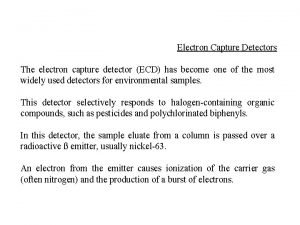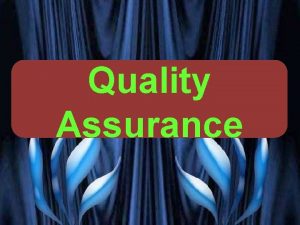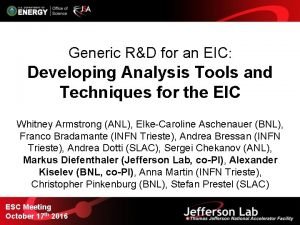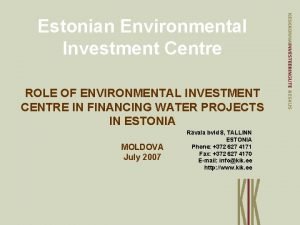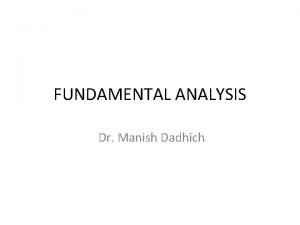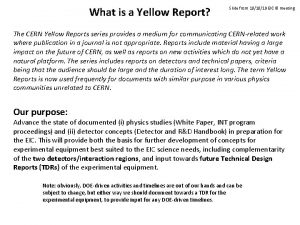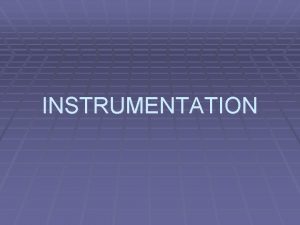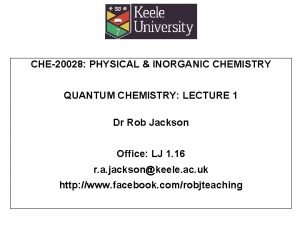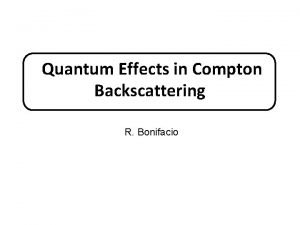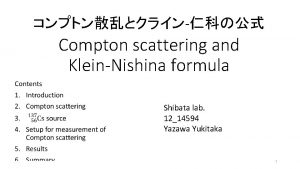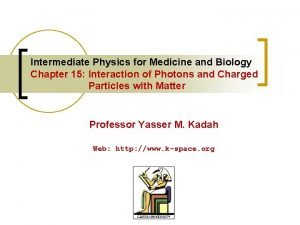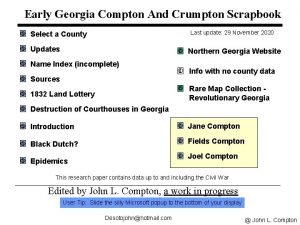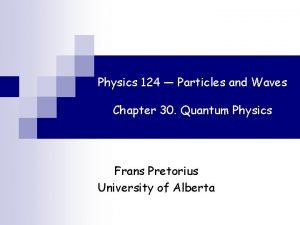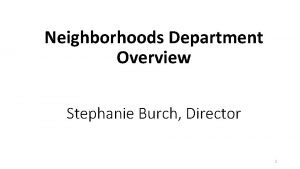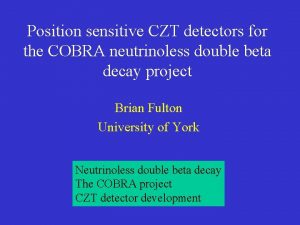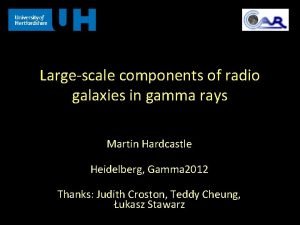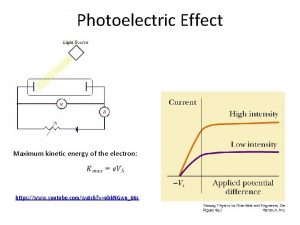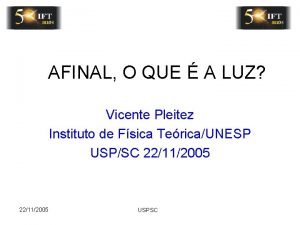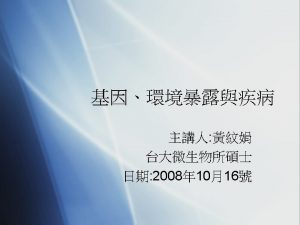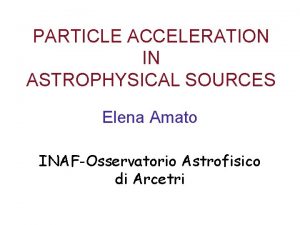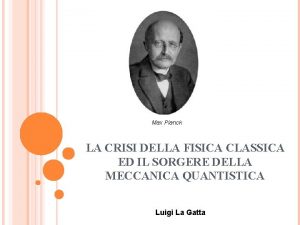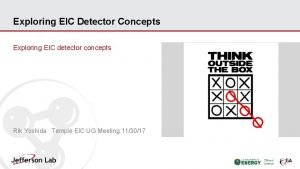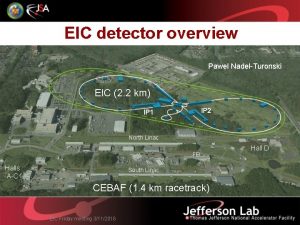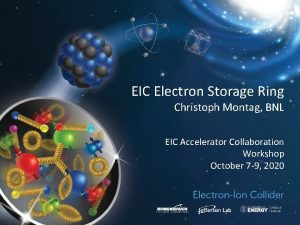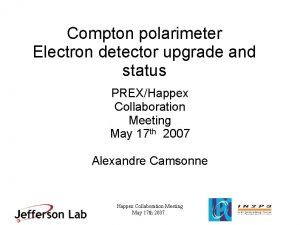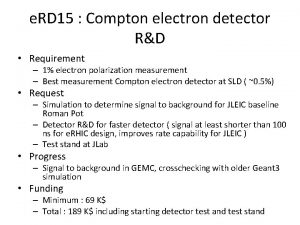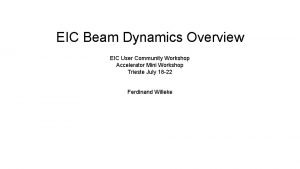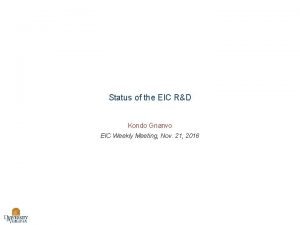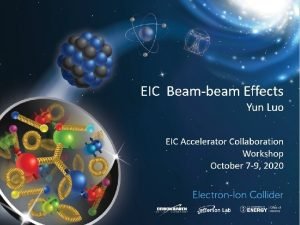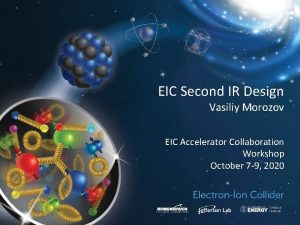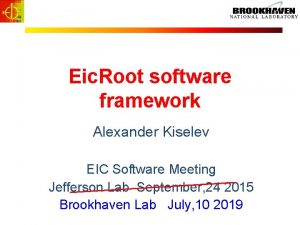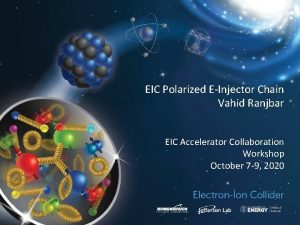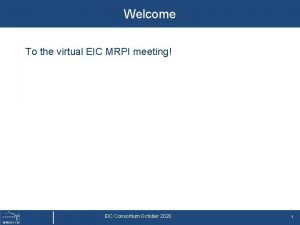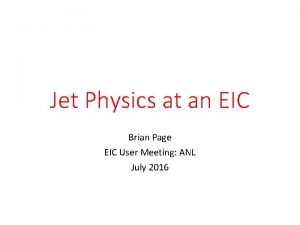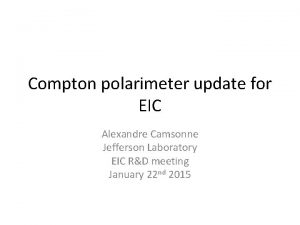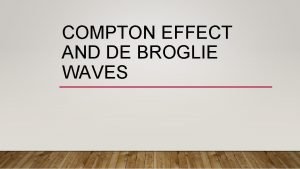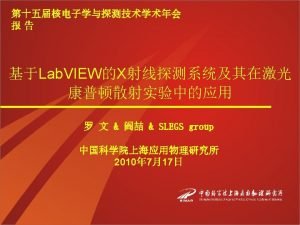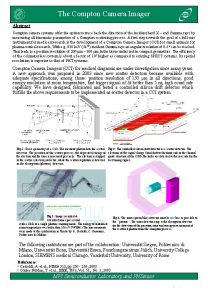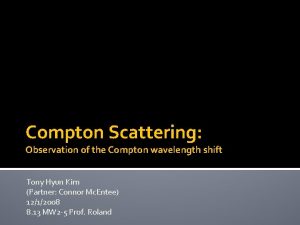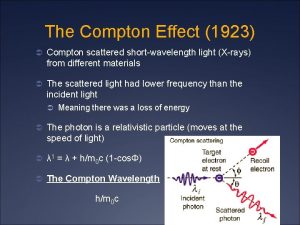e RD 15 Compton electron detector RD EIC

























- Slides: 25

e. RD 15 Compton electron detector R&D EIC R&D meeting July 6 -7 th 2016 Alexandre Camsonne

e. RD 15 : Compton electron detector R&D • Requirement – 1% electron polarization measurement – Best measurement Compton electron detector at SLD ( ~0. 5%) • Deliverables – Simulation to determine signal to background for JLEIC baseline Roman Pot and expected accuracy – Detector R&D for faster detector ( signal at least shorter than 100 ns for e. RHIC design, improves rate capability for JLEIC ) – Test stand at JLab to measure precision polarization with the foreseen detector for EIC

Compton polarimeter Laser + Fabry Perot cavity Compton photon calorimeter e- beam to spin rotator 3 Low-Q 2 tagger for low-energy electrons gc Compton electron tracking detector Compton- and low-Q 2 electrons are kinematically separated! Luminosit y monitor ebeam from IP Photons from IP

Laser studies ( Gaskell ) , 10 W Photon detector • Compton signal in blue • 10 W laser power is marginal for the photon detector Electron detector • Reasonable signal to noise for the electron detector Bremstrahlung 4

Laser studies ( Gaskell ) 1 k. W of laser power Halo contribution for small and large apertures, 2 cm aperture 5

Measurement times Typical measurement takes less than 1 second even at 10 Watts of laser power 6

Beamline Geometry in GEMC • Beam pipe implemented • All presentation simulation results only done with the chicane to speed up the studies • Will install on batch to run high statistics and full setup 7

Signal to background with GEMC • • Reused Richard Petti e. RD 12 event generator 1 A 1 k. W 5 Ge. V All Geant 4 processes Signal is consistent with Geant 3 simulation

Compton Asymmetry Compton asymmetry can be produced, amplitude close to what is expected. Some issue in the first and last bin to be checked. 9

Radiation dose in the detector • • About 30 k. Rad/hr at 1 A and 1 k. W laser power per strip, 3 Mrad/hr for whole detector Consistent with estimation from a previous experiment in Hall C which showed no damaged after 10 Mrad ( 3 hours at JLEIC ) Most radiation damage comes from signal, lower duty cycle ( measurement every 10 minutes ) and lower laser power at 10 W ensure detector operating for several years Radiation hard detector allows more continuous measurement 10

Compton asymmetry with window • Roman pot design introduces a 500 mm thin steel window in front of the detector. Preliminary results with low statistics seems to show that there is little change introduced by the window • To be confirmed with high statistics and polarization extraction analysis 11

Synchrotron radiation Not in direct view of synchrotron fan Compton photon calorimeter Low-Q 2 tagger for low-energy electrons gc Compton electron tracking detector e- beam to spin rotator Compton- and low-Q 2 electrons are kinematically separated! gc Beam pipe wall e- beam to spin rotator 12 Luminosit y monitor ebeam from IP Photons from IP Can see still see synchtrotron Compton electronbouncing on the beam tracking detector pipe Can add structure and coating to reduce it

Roman pots from TOTEM • For small angle detection • Two chambers • Thin window • Can be moved in and out from beam • Typical 10 to 15 sigma • Up to 4 -5 sigma in optimal places • Might work for electron side at e. RHIC but solution of exit window with calorimeter is planned for now ( easier solution if optics permits )

Wakefield progress 14

Test stand • Compton polarimeter was demonstrated to achieve 1 % systematic with photon at 1 to 3 Ge. V • Prove detector technology with pulses shorter than 100 ns in beam • Crosscheck accuracy of electron detector for EIC • Could consider Roman Pot but more expensive

Electronics • Available electronics • 768 A/D for silicon • spare 192 channels • 32 channels analog for silicon • 256 A/D for diamond • 96 spares channels • Would like to acquire • 1 channel of CIVIDEC amplifier • SAMPIC • 32 channels sampling • Up to 8. 2 GHz • Low cost 4. 2 K$ • Allow study of several channels and record very fast pulses 16

TOTEM detectors • Diamond detector • Current TOTEM detector and electronics should accommodate e. RHIC need to separate the different source • Polarimetry only needs moderate timing resolution : will test with amplifier discriminator

Lower chamber designed • Lower chamber designed and costed • Compatible with Hall C diamond detector • Integrated in Hall A beamline 18

Proposal for 2017 • Continue postdoc funding to complete simulation work • Increase travel money for collaboration with KU on Wakefield, electronics and detector • Procure amplifier and readout for bench test at Jlab before beam test • Build lower chamber for beam test 19

Deliverable for 2017 • Simulation – – – – – • Fix beam pipe in magnet More cross check with old simulation In boxes, Full simulation with Interaction Region and beam pipe completion Run simulation large scale on batch farm will full setup expected for Halo modelling next R&D Model beam laser interaction meeting Implement polarization extraction analysis Study of systematics and optimization of the setup Synchrotron radiation study, detector response to synchrotron photons Wakefield Higher Order Mode – Run first pass simulation and determine if Roman Pot is doable for Compton Electron detector • Test stand – Procure Amplifier and SAMPIC and setup bench – Multichannel amplifier design and multichannel discriminator board design – Complete design of the chamber, delayed because of designer time and change in design of connectors for the Amplifier Discriminator boards – Measure detector pulse width on the bench 20

Manpower Individual Institution Percentage in % Task Alexandre Camsonne Jefferson Lab 20 Wakefield, general, postdoc supervision David Gaskell Jefferson Lab 5 Geant 3, laser system, postodoc supervision Joshua Hoskins U. Manitoba 50 GEMC full simulation Michael Sullivan SLAC advisory Synchrotron Haipeng Wang Jlab SRF advisory Wakefield Robert Rimmer JLAB SRF advisory Wakefield Christophe Royon Kansas U. 5 Detector, electronics, Wakefield Nicola Minafra Kansas U. 5 Detector, electronics, Wakefield Michael Murray Kansas U. 5 Detector, electronics, Wakefield 21

Budget K$ direct Quantity K$ direct Cumulative Direct K$ Total Cost K$ Cumulative Total (K$) Post doc 22 1 22 22 33. 99 Travel 15 1 15 37 23. 175 57. 165 CIVIDEC Amp 3. 6 1 3. 6 40. 6 5. 562 62. 727 SAMPIC cost 4. 2 1 4. 2 44. 8 6. 489 69. 216 Amplifier 20 1 20 64. 8 30. 9 100. 116 Detector Si 2 1 2 66. 8 3. 09 103. 206 Detector Diamond 3 1 3 69. 8 4. 635 107. 841 Wirebonding 5 1 5 74. 8 7. 725 115. 566 Discriminator 20 1 20 94. 8 30. 9 146. 466 10 104. 8 15. 45 161. 916 7. 5 112. 3 11. 5875 173. 5035 5 117. 3 7. 725 181. 2285 Total 181. 23 K$ Lower chamber Detector holder Test flange 22

Conclusion • First signal to background plots – 10 W laser seems sufficient but need full background • Wakefield – Tools and collaboration to make the study in place • Simulation in place – Run in batch for full background and high statistics – Need implement background analysis to study effect of background and shielding 23

Backup slides 24

TOTEM CIVIDEC amplifier • Fast amplifier used with TOTEM diamond detector • About 3 K$ per channel • Plan to procure one • Multichannel amplifier development planned ( need 768 channels ) 25
 Electron capture detector
Electron capture detector Myfiu account
Myfiu account Yellow report eic
Yellow report eic Qa eic patel
Qa eic patel Eic health certificate
Eic health certificate Eic software reviews
Eic software reviews Eic european investment centre
Eic european investment centre Eic approach of fundamental analysis
Eic approach of fundamental analysis Kickoff meting
Kickoff meting Compton
Compton Compton scattering
Compton scattering Compton backscattering
Compton backscattering Compton effect formula
Compton effect formula Compton effect
Compton effect Gwinette county court
Gwinette county court Compton wavelength
Compton wavelength Stephenie compton email
Stephenie compton email Aeronet compton
Aeronet compton Inverse compton
Inverse compton Photoelectric effect maximum kinetic energy
Photoelectric effect maximum kinetic energy Victorian curriculum economics and business
Victorian curriculum economics and business Fóton
Fóton Watson health francisco 1b
Watson health francisco 1b Compton olayi
Compton olayi Elena amato
Elena amato Crisi della fisica classica
Crisi della fisica classica
